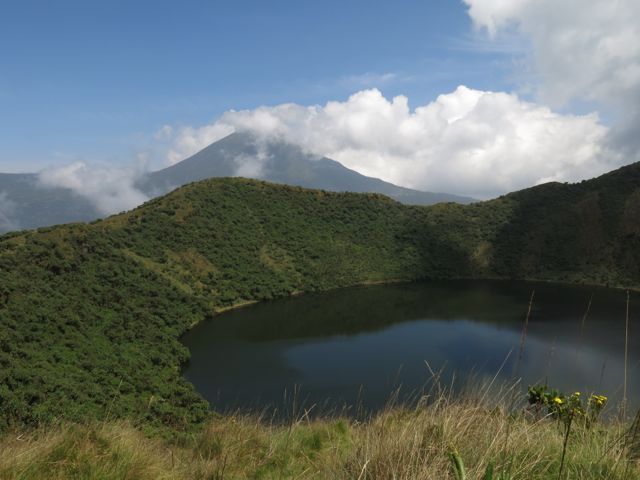Karisimbi Volcano is the highest of the Virunga volcanoes and is among the highest mountains peaks in Africa. Karisimbi Volcano is believed to receive snow during some months in the year which is a phenomenon because of its location near the equator.
Karismbi Volcano derives Its name stems from word “amasimbi” in local Kinyarwanda dialect and means snow. Karismbi Mountain is believed to be home to spirits and there are many legends associated with it.

View of a crater on top of Karismbi Volcano in Rwanda
Mountain hikers that visit Rwanda prefer to take a hike to Karisimbi Volcano a more challenging hike in the Virungas massif and perhaps the best volcano hiking experience in Rwanda. Karisimbi Volcano is so unique and beautiful with a symmetrical sharp-peaked summit. The 2-km-wide Branca caldera, located SE of the 4507-m-high summit, is filled by viscous lava flows and two explosion craters. The large, 1.2-km-wide Muntango pit crater is located south of the summit of the basanitic-to-trachytic volcano. A broad lava plain, formed from lava flows erupted within the caldera and along a chain of parasitic cones.
Unlike all the other volcanoes that are for one day hikes, the Hiking Karisimbi Volcano takes minimum 2 days before descending back to base of the mountain. Camping is done on the mountain at an elevation 3700m/12139ft.
Best time for Hiking Karismbi Volcano in Rwanda
Hiking Mount Karismbi is recommended in dry season. The dry seasons are when there is less rainfall and more sunshine and this is during the months from June to August and December to February. The dry season is the best time because the trails are dry and climbing is therefore easier. The other months (March, April, May & September, October, November) make up the wet seasons and during this time there are frequent rains which render the trails very muddy and the hike is difficult. However the scenery is best during the wet season and can turn out to be the best time to hike if you are ready for the challenge of a difficult hike.
A List below of other Mountains that make up the Virunga Massif – part of Karisimbi Volcano
Mount Bisoke
3711m/12175ft is Mountain Bisoke located on the border with the Democratic Republic of Congo. It is a dormant volcano with a massive crater lake at in the peak measuring about 400m in diameter and fully lies in Rwanda. Mount Bisoke Crater Lake is the most popular trail for hiking tours in Volcanoes National Park as hikers aim to reach this beautiful Crater Lake at the peak. Mountain Bisoke is also located closer to the center of the Virungas and thus offers stunning views of the chain. You can even catch sight of the sharp peak of Mounatain. Mikeno in the Congo. The difficulty level of this hike can be put at challenging to difficult but can be done even by none experienced hikers, however good fitness is very important for one to enjoy the trek. The round trip is about 6 hours, with 4 hours climbing up and 2 climbing down.
Mount. Muhabura
4127m/13540ft is Mount Muhabura shared between Rwanda and Uganda. It is located on the end/start of the volcano chain. The trek on Mount Muhabura offers wonderful views of the mountainous landscape. One can also view the twin lakes Burera and Ruhondo below. At the peak of the Mt. Muhabura is also beautiful Crater Lake. The round trip is about 6 – 8 hours. Since it is quite high it requires a good fitness and endurance.
Mount. Gahinga
3474m/11398ft is Mount Gahinga the shortest mountain in Volcanoes National Park. It is the least hiked in the park. For none seasoned hikers this may be a good one to start with before taking on the more challenging mountains in the chain.
Rwanda indeed has a lot to offer to visitors that seek full adventure in Africa. Besides exploring the great Virunga Mountains one can get on a visit the most pristine forests of Nyungwe National Park to track Chimpanzees in Rwanda and do the canopy walk tour in Rwanda.
